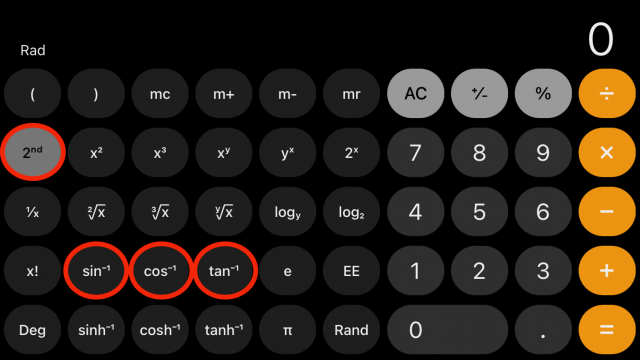逆三角関数 \(\sin^{-1} x , \ \cos^{-1} x,\ \tan^{-1} x \) の微分。
$$\frac{d}{dx} \sin^{-1} x = \frac{1}{\sqrt{1-x^2}}, \quad \frac{d}{dx} \cos^{ -1} x = -\frac{1}{\sqrt{1-x^2}}, \quad \frac{d}{dx} \tan^{-1} x = \frac{1}{1 + x^2}$$
を示す。
三角関数 \(\sin x, \cos x, \tan x\) の逆関数を一般に逆三角関数という。逆三角関数はスマホアプリの「計算機」にも搭載されています。(以下は iPhone の例。横向きにして 2nd をクリックする。)

例えば, \( y = \sin x \) の逆関数とは,方程式 \( y = \sin x \) を \(x\) について解いて \(x = \sin^{-1} y \) と書き, \( \sin^{-1} \) の部分を「アークサイン」と読む。
あらためて \(x\) と \( y\) を取り替えて書き,\( y = \sin^{-1} x \) (ワイ・イコール・アークサイン・エックス)は \(y = \sin x\) の逆関数であるという。このとき,\(x \) と \( y\) が1対1対応するために,\( -1 \leq x \leq 1\) に対して \(\displaystyle -\frac{\pi}{2} \leq y \leq \frac{\pi}{2}\) の範囲(「主値」)に制限している。以下にまとめておく。
逆三角関数の定義
$\sin^{-1} x$ または アークサイン $\arcsin x$
$$y = \sin^{-1} x = \arcsin x$$(ワイ・イコール・アークサイン・エックス)は \(y = \sin x\) の逆関数(つまり,方程式 \(x = \sin y\) を \(y\) について解いたもの)であり,その定義域と値域は
$$-1 \leq x \leq 1, \qquad -\frac{\pi}{2} \leq y \leq \frac{\pi}{2}$$
$\cos^{-1} x$ または アークコサイン $\arccos x$
$$ y = \cos^{-1} x = \arccos x$$ (ワイ・イコール・アークコサイン・エックス)は \(y = \cos x\) の逆関数(つまり,方程式 \(x = \cos y\) を \(y\) について解いたもの)であり,その定義域と値域は
$$-1 \leq x \leq 1, \qquad 0 \leq y \leq \pi$$
$\tan^{-1} x$ または アークタンジェント $\arctan x$
$$ y = \tan^{-1} x = \arctan x$$ (ワイ・イコール・アークタンジェント・エックス)は \(y = \tan x\) の逆関数(つまり,方程式 \(x = \tan y\) を \(y\) について解いたもの)であり,その定義域と値域は
$$-\infty < x < \infty, \qquad -\frac{\pi}{2} < y < \frac{\pi}{2}$$
逆三角関数の微分
$\sin^{-1} x$ の微分
$y = \sin^{-1} x$ の微分は,まずこれが $x = \sin y$ を $y$ について解いたものだということを思い出す。すると,$x$ は $y$ の関数として三角関数で書けているので,
$$\frac{dx}{dy} = \frac{d}{dy} \sin y = \cos y$$
$$ \frac{dy}{dx} = \frac{1}{\frac{dx}{dy}}$$
を使うと,$$\frac{d}{dx} \sin^{-1} x = \frac{dy}{dx} = \frac{1}{\frac{dx}{dy}} = \frac{1}{\cos y} = \frac{1}{\sqrt{1-\sin^2 y}} = \frac{1}{\sqrt{1-x^2}}$$
$\cos^{-1} x$ の微分
$y = \cos^{-1} x$ の微分は,まずこれが $x = \cos y$ を $y$ について解いたものだということを思い出す。すると,$x$ は $y$ の関数として三角関数で書けているので,
$$\frac{dx}{dy} = \frac{d}{dy} \cos y = -\sin y$$
$$ \frac{dy}{dx} = \frac{1}{\frac{dx}{dy}}$$
を使うと,$$\frac{d}{dx} \cos^{-1} x = \frac{dy}{dx} = \frac{1}{\frac{dx}{dy}} = \frac{1}{-\sin y} = \frac{1}{-\sqrt{1-\cos^2 y}} = -\frac{1}{\sqrt{1-x^2}}$$
また,\( y = \cos^{-1} x \) は\(x = \cos y\) の逆関数であるから,
$$ x = \cos y = \sin\left(\frac{\pi}{2} -y\right), \quad\therefore\ \ \sin^{-1} x = \frac{\pi}{2} -y$$
$$\therefore\ \ \cos^{-1} x + \sin^{-1} x = y + \frac{\pi}{2} -y = \frac{\pi}{2}$$改めて書くと,以下のような関係がある。
$$\cos^{-1} x + \sin^{-1} x = \frac{\pi}{2}, \quad\therefore\ \ \cos^{-1} x = -\sin^{-1} x + \frac{\pi}{2}$$
\((\cos^{-1} x)\) の微分が \(\sin^{-1} x\) の微分にマイナスがついたものであることは,このことから明らかであろう。
$\tan^{-1} x$ の微分
$y = \tan^{-1} x$ の微分は,まずこれが $x = \tan y$ を $y$ について解いたものだということを思い出す。すると,$x$ は $y$ の関数として三角関数で書けているので,
$$\frac{dx}{dy} = \frac{d}{dy} \tan y = \frac{1}{\cos^2 y}$$
$$ \frac{dy}{dx} = \frac{1}{\frac{dx}{dy}}$$
を使うと,
$$\frac{d}{dx} \tan^{-1} x = \frac{dy}{dx} = \frac{1}{\frac{dx}{dy}} = \cos^2 y = \frac{1}{1 + \tan^2 y} = \frac{1}{1 + x^2}$$
また,$y = \tan^{-1} x$ は $ x = \tan y$ の逆関数であるから,
\begin{eqnarray}
x &=& \tan y = \frac{\sin y}{\cos y} \\
&=& \frac{\cos\left(\frac{\pi}{2} -y\right)}{\sin\left(\frac{\pi}{2} -y\right)} \\
&=& \frac{1}{\tan\left(\frac{\pi}{2} -y\right)}
\end{eqnarray}
つまり,$\displaystyle x = \frac{1}{\tan\left(\frac{\pi}{2} -y\right)}$ すなわち $\displaystyle \tan\left(\frac{\pi}{2} -y\right) = \frac{1}{x}$ より
$$ \frac{\pi}{2} -y = \tan^{-1} \frac{1}{x}$$
$$\therefore\ \ \tan^{-1} x + \tan^{-1} \frac{1}{x} = y + \frac{\pi}{2} -y = \frac{\pi}{2}$$
逆三角関数の表記法
\( \displaystyle (\sin x)^{-1} = \frac{1}{\sin x}\) なので,つい以下のような間違いをしてしまうこともあるかもしれない。
\(\displaystyle \sin^{-1} x = \frac{x}{\sin} \)(大間違い!!)とか,\(\displaystyle \sin^{-1} x = \frac{1}{\sin x} \) (間違い!!)などと誤解してしまう恐れがあるので,このようなお茶目な間違いを誘発しないように,逆三角関数に対して以下のような表記法を用いることもある。
$$\sin^{-1} x = \arcsin x, \quad \cos^{-1} x = \arccos x, \quad \tan^{-1} x = \arctan x$$
また,コンピュータ言語では,三角関数を
sin(x), cos(x), tan(x)
逆三角関数をそれぞれ以下のように表記する場合がある。
asin(x), acos(x), atan(x)
参考:逆三角関数の間の関係
上で得られた逆三角関数の間の関係をまとめておくと,(特に以下の2つは宇宙論のところで実際に使う)
$$\cos^{-1} x + \sin^{-1} x = \frac{\pi}{2}$$
$$\tan^{-1} x + \tan^{-1} \frac{1}{x} = \frac{\pi}{2}$$
半角の公式から得られる関係
Wikipedia の逆関数の項には,その他にもいろいろな逆三角関数の間の関係が掲載されている。
後々使う可能性があるのは(実際に宇宙論の項で使う),以下の半角の公式から得られる,いくつかの関係。まず,
\begin{eqnarray}
\tan^2 \frac{\theta}{2} &=& \frac{\sin^2\frac{\theta}{2}}{\cos^2\frac{\theta}{2}} \\
&=& \frac{1 -\cos\theta}{1 + \cos\theta} \\
&=& \frac{\sin^2\theta}{(1 + \cos\theta)^2} \\ \ \\
\therefore\ \ \tan \frac{\theta}{2} &=& \frac{\sin\theta}{1 + \cos\theta} \\
&=& \frac{\sqrt{1 -\cos^2\theta}}{1 + \cos\theta} \tag{1}\\
&=& \frac{\sin\theta}{1 + \sqrt{1 -\sin^2\theta}} \tag{2}\\
&=& \frac{\tan\theta}{1 + \sqrt{1 + \tan^2\theta}} \tag{3}
\end{eqnarray}
$(1)$ の $\displaystyle \tan \frac{\theta}{2} = \frac{\sqrt{1 -\cos^2\theta}}{1 + \cos\theta} $ より
\begin{eqnarray}
\frac{\theta}{2} &=& \tan^{-1}\left(\frac{\sqrt{1 -\cos^2\theta}}{1 + \cos\theta} \right)
\end{eqnarray}
$\theta \equiv \cos^{-1} x$ とおくと,
\begin{eqnarray}
\cos^{-1} x&=& 2 \tan^{-1}\left(\frac{\sqrt{1 -x^2}}{1 +x} \right)
\end{eqnarray}
次に,$(2)$ の $\displaystyle \tan \frac{\theta}{2} = \frac{\sin\theta}{1 +\sqrt{1 -\sin^2\theta}} $ より
\begin{eqnarray}
\frac{\theta}{2} &=& \tan^{-1}\left(\frac{\sin\theta}{1 +\sqrt{1 -\sin^2\theta}} \right)
\end{eqnarray}
$\theta \equiv \sin^{-1} x$ とおくと,
\begin{eqnarray}
\sin^{-1} x&=& 2 \tan^{-1}\left(\frac{x}{1 +\sqrt{1 -x^2} } \right)
\end{eqnarray}
また,$(3)$ から以下の関係もわかるだろう。
\begin{eqnarray}
\tan^{-1} x&=& 2 \tan^{-1}\left(\frac{x}{1 +\sqrt{1 + x^2} } \right)
\end{eqnarray}
倍角の公式から得られる関係
\begin{eqnarray}
\cos(2\theta) &=& \cos^2\theta -\sin^2\theta \\
&=& \cos^2\theta (1 -\tan^2\theta)\\
&=& \frac{1 -\tan^2\theta}{1 + \tan^2\theta} \\
\therefore \ \ 2 \theta &=& \cos^{-1} \left(\frac{1 -\tan^2\theta}{1 + \tan^2\theta} \right)
\end{eqnarray}
上式で $\theta \equiv \tan^{-1} x$ とおくと,
\begin{eqnarray}
2 \tan^{-1} x &=& \cos^{-1} \left(\frac{1 -x^2}{1 + x^2} \right)
\end{eqnarray}
次に,
\begin{eqnarray}
\sin(2\theta) &=& 2 \sin\theta \cos\theta \\
&=& 2 \tan\theta \cos^2\theta\\
&=& \frac{ 2\tan\theta}{1 + \tan^2\theta} \\
\therefore \ \ 2 \theta &=& \sin^{-1} \left(\frac{ 2\tan\theta}{1 + \tan^2\theta} \right)
\end{eqnarray}
上式で $\theta \equiv \tan^{-1} x$ とおくと,
\begin{eqnarray}
2 \tan^{-1} x &=& \sin^{-1} \left(\frac{ 2x}{1 + x^2} \right)
\end{eqnarray}
また,
\begin{eqnarray}
\tan (2\theta) &=& \frac{2 \tan\theta}{1 -\tan^2\theta} \\
\therefore \ \ 2 \theta &=& \tan^{-1} \left(\frac{2 \tan\theta}{1 -\tan^2\theta} \right)
\end{eqnarray}
上式で $\theta \equiv \tan^{-1} x$ とおくと,
\begin{eqnarray}
2 \tan^{-1} x &=& \tan^{-1} \left(\frac{2 x}{1 -x^2} \right)
\end{eqnarray}
ここでのまとめ:
\begin{eqnarray}
2 \tan^{-1} x &=& \cos^{-1} \left(\frac{1 -x^2}{1 + x^2} \right)\\
&=& \sin^{-1} \left(\frac{ 2x}{1 + x^2} \right) \\
&=& \tan^{-1} \left(\frac{2 x}{1 -x^2} \right)
\end{eqnarray}
逆三角関数のグラフ
3つまとめてグラフにすると…